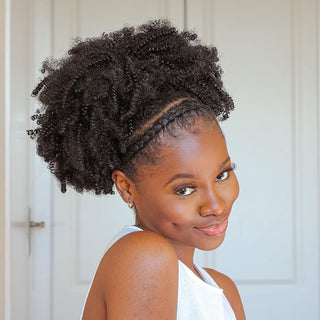We all love to put it off for as long as possible, but trims are an essential part of a healthy curly hair routine. No matter how much you keep your hair moisturised and clean, soon enough you'll start to notice a few snags here and there- which is why incorporating a trim into your routine is essential.
Now, although you can get your hair trimmed by a stylist for a precise cut, there are times when you may choose to DIY the whole thing. So, to save you from a trimming session that ends in tears, in this article, we'll be covering everything you need to master the at-home trims on your curly hair.
Signs It's Time For A Trim
Split Ends
Your ends are the oldest part of the hair. So, they tend to get weak and brittle quite often, which can cause the hair to split. Split ends aren't necessarily a sign of unhealthy hair, it is just something that happens over time as a result of daily wear and tear. However, since there is no real way to treat them, your only option is to cut them off. So, if your ends feel rough and frayed with a lot more split ends than you'd like, it may be time to stop delaying your trim.
Single Strand Knots
Single strands AKA fairy knots are small knots that form along the hair strands as a result of your curls lopping around themselves. While the occasional fairy knot here and there is normal when you have curly hair, if you start to notice a lot of them in different sections of the hair, that means you need a trim.
Difficulty Detangling
When your curls have accumulated breakage along different strands, you'll notice they feel rougher and much harder to detangle. If you find yourself playing tug of war with your comb every time you try to detangle no matter how much product you have on, it is definitely time for a trim.
Excessive Breakage and Frizz
Although it is natural for the hair to shed a few strands daily, an increase in the amount of hair coming off every time you style or detangle is a sign of breakage. If you notice short strands of hair constantly falling out, then it is time for a snip.

Benefits Of Trimming Your Hair
We know most people with curly hair love to hold on to every inch of their precious curls and are not the biggest fan of trimming. But a trim can actually be very beneficial for the overall health of your hair. By cutting off the breakage, knots and tangles, you'll notice your hair feels more manageable and easier to comb and style.
Trimming also helps you get rid of all the dead ends and damage that prevent you from retaining length. This means in the long term you'll notice an increase in the length of your hair, bringing you closer to achieving your hair growth goals.
How Often Should You Trim?
We would recommend trimming your hair every three to six months to keep it healthy. However, if you aim to grow long hair, then keep the cuts to once or twice a year at best to avoid chopping off the length you worked so hard to retain. Whenever you do trim, be cautious about how much hair you take off. You only need to cut off about a quarter to half an inch of hair each time. At most one inch in the most extreme cases of split ends and breakage.

How To Trim Your Curly Hair (Three Ways)
Before cutting your hair, it is important to start on clean hair. If your hair is dirty, all the buildup and oil stuck on the strands will make it difficult for your scissors to get a clean cut, leaving you with uneven or frayed ends. When your hair is freshly washed with a shampoo like Sofnfree's Manuka Honey Shampoo, your strands will be clean, soft, and primed for your trim. Plus, you'll be able to feel and see any single-strand knots that need to be taken care of.
After shampooing, follow up with our Moisture-rich conditioner or Manuka Honey Deep Conditioning Mask to replenish the hair with moisture and make it softer and more manageable. Once you have rinsed out all the product from your hair you can then dive into your preferred trimming method.
Twists
- Starting on freshly washed hair. Divide the hair into four sections.
- Apply our Manuka Honey & Avocado Oil leave-in conditioner to moisturise and smoothen each section of the hair.
- Use a wide tooth comb or brush to detangle each section from ends to root. Be sure to incorporate finger detangling to remove all tangles.
- Divide each section into 2-4 smaller subsections and twist each one.
- Now, grab each twist and look at the ends. Identify which point on the twists the hair starts to look frayed and uncurled (those are the unhealthy ends)
- Use your scissors to trim the unhealthy ends and repeat the process for all the twisted sections. Then proceed with styling your hair.
Blow Drying
- After washing the hair, apply Sofnfree's leave-in conditioner and divide the hair into four sections.
- Use a wide tooth comb to detangle each section from ends to roots.
- Working one section at a time, pull the hair tautly and use a blow dryer to properly dry the hair and give it a slight stretch.
- Now use a detangling brush or paddle brush to gently detangle the section once again
- Pass a fine-tooth comb through the section of hair from root to ends. As you comb through, you will feel slight resistance towards the ends of the hair. That is where the split ends and tangle are. Pass the comb through the hair 2-3 times to be sure.
- Once you have identified what part of the ends needs to be cut. Make a mental note of where that is, then place the hair between your index and middle finger with hair pulled lightly.
- Use the scissors to cut the ends. You should trim off no more than a quarter to one inch of hair.
- Repeat the process for all the other sections and then use a brush to comb through the whole head one last time for good measure.
Search And Destroy
- Divide the hair into 6-10 sections
- Detangle each section with a wide tooth comb or finger detangle until the hair feels smooth.
- Working one section at a time, running your hands through the hair to identify and search for any knots or tangles on individual strands of hair. Use a hair clip to secure the section you are not working on.
- Use scissors to cut off any snags or split ends that you find and repeat the entire process for the whole head.
Note: This method is best used when you do not want to do a full trim on the hair. It helps you dust off any damaged sections, but it does not replace a full trim. So do not make this method your main trimming method all year round or you will end up with uneven ends.
Things To Avoid When Trimming The Hair
Avoid Not Using Hair Scissors
Avoid using regular scissors that are not meant for cutting hair. They are usually not sharp enough to make a straight cut and will likely lead to split ends and further breakage. Make sure to use good quality shears that are sharp.
Avoid Cutting In Large Sections
Your curly hair likely differs in length at each section of the hair. So, it is best to avoid cutting in extremely large sections to get a more precise and even cut all over the head. Stick with smaller sections so you can see which strands have knots and snags that need special attention.
Avoid Making Slanted Cuts
When cutting your hair, avoid placing the scissors at a slanted angle as they can leave you with an uneven cut. Slanted cuts can also leave you with frayed ends that can turn into breakage over time. Ensure line up as horizontally straight as you can get when trimming your ends.
Regular trims are an important step for keeping your hair healthy and intact. The thought of cutting your own hair may seem like a daunting task at first but if you stick with the tips in this guide, the whole process will be hassle-free. So don't be afraid to grab your hair shears when needed, your curls will thank you for the special attention.

